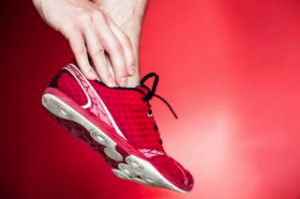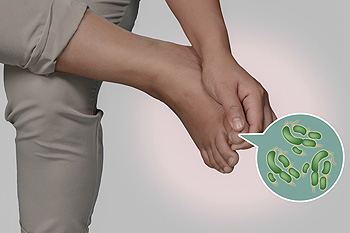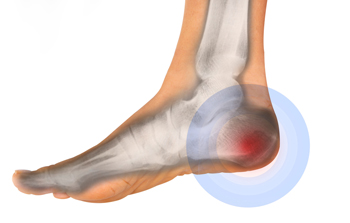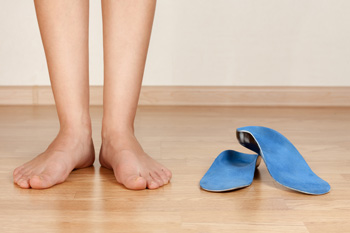Items filtered by date: October 2018
What Causes Tarsal Tunnel Syndrome?
 A common cause of the condition that is referred to as tarsal tunnel syndrome may occur as a result of constant overuse of the ankle. The most common reason for this to happen may be from power walking, frequent running, or standing for the majority of the day. It typically affects the nerve that is on the inside of the foot and ankle, and when this becomes damaged, inflammation and tenderness may occur. Research has shown the importance of treating tarsal tunnel syndrome promptly to avoid the possibility of permanent nerve damage from developing. Treatment options may begin with resting and elevating the foot, which may reduce inflammation, in addition to taking anti-inflammatory medications, which may help in alleviating a portion of the pain that often accompanies this condition. If you feel you may have tarsal tunnel syndrome, please speak to a podiatrist as quickly as possible for a proper evaluation and to discuss the best treatments techniques for you.
A common cause of the condition that is referred to as tarsal tunnel syndrome may occur as a result of constant overuse of the ankle. The most common reason for this to happen may be from power walking, frequent running, or standing for the majority of the day. It typically affects the nerve that is on the inside of the foot and ankle, and when this becomes damaged, inflammation and tenderness may occur. Research has shown the importance of treating tarsal tunnel syndrome promptly to avoid the possibility of permanent nerve damage from developing. Treatment options may begin with resting and elevating the foot, which may reduce inflammation, in addition to taking anti-inflammatory medications, which may help in alleviating a portion of the pain that often accompanies this condition. If you feel you may have tarsal tunnel syndrome, please speak to a podiatrist as quickly as possible for a proper evaluation and to discuss the best treatments techniques for you.
Tarsal tunnel syndrome can be very uncomfortable to live with. If you are experiencing tarsal tunnel syndrome, contact one of our podiatrists of Pennsylvania. Our doctors can provide the care you need to keep you pain-free and on your feet.
Tarsal Tunnel Syndrome
Tarsal tunnel syndrome, which can also be called tibial nerve dysfunction, is an uncommon condition of misfiring peripheral nerves in the foot. The tibial nerve is the peripheral nerve in the leg responsible for sensation and movement of the foot and calf muscles. In tarsal tunnel syndrome, the tibial nerve is damaged, causing problems with movement and feeling in the foot of the affected leg.
Common Cause of Tarsal Tunnel Syndrome
- Involves pressure or an injury, direct pressure on the tibial nerve for an extended period of time, sometimes caused by other body structures close by or near the knee.
- Diseases that damage nerves, including diabetes, may cause tarsal tunnel syndrome.
- At times, tarsal tunnel syndrome can appear without an obvious cause in some cases.
The Effects of Tarsal Tunnel Syndrome
- Different sensations, an afflicted person may experience pain, tingling, burning or other unusual sensations in the foot of the affected leg.
- The foot muscles, toes and ankle become weaker, and curling your toes or flexing your foot can become difficult.
- If condition worsens, infections and ulcers may develop on the foot that is experiencing the syndrome.
A physical exam of the leg can help identify the presence of tarsal tunnel syndrome. Medical tests, such as a nerve biopsy, are also used to diagnose the condition. Patients may receive physical therapy and prescriptive medication. In extreme cases, some may require surgery.
If you have any questions please feel free to contact one of our offices located in Plymouth Meeting and Ambler, PA . We offer the newest diagnostic and treatment technologies for all your foot and ankle needs.
It’s Important to Stretch Your Feet While Working
 There are many professions where it is necessary to stand for the majority of the day. People who are employed as nurses may be standing and walking, while performing the necessary functions to take proper care of their patients. Research has shown the importance of stretching the feet, which may promote improved circulation. When the shoes are changed frequently or the correct insoles are worn, the feet will feel more comfortable. Practicing yoga has been known to stretch the muscles, toes, and tendons in the feet. This may also develop additional flexibility. If you are in a profession where you are walking most of the day, please speak to a podiatrist about proper stretching techniques, which may prevent painful foot conditions from developing.
There are many professions where it is necessary to stand for the majority of the day. People who are employed as nurses may be standing and walking, while performing the necessary functions to take proper care of their patients. Research has shown the importance of stretching the feet, which may promote improved circulation. When the shoes are changed frequently or the correct insoles are worn, the feet will feel more comfortable. Practicing yoga has been known to stretch the muscles, toes, and tendons in the feet. This may also develop additional flexibility. If you are in a profession where you are walking most of the day, please speak to a podiatrist about proper stretching techniques, which may prevent painful foot conditions from developing.
While working on the feet, it is important to take the proper care of them. For more information about working on your feet, contact one of our podiatrists from Pennsylvania. Our doctors will treat your foot and ankle needs.
Working on Your Feet
Standing on your feet for long periods of time can cause stress and pain in your feet. Your whole body may experience change in terms of posture, back pain, bunions, callouses and or plantar warts. There are ways to avoid these conditions with proper foot care, smart choices and correct posture.
Positive Changes
Negative heeled shoe – Choosing this shoe type places the heel slightly lower than the ball of the foot. These are great for overall foot health. Find shoes that fit you correctly.
Go barefoot – Our feet were not designed to be enclosed for all hours of the day. Try to periodically expose your feet to air.
Eliminate Pain
Foot Exercises – Performing simple exercises, incorporating yoga and doing stretches are beneficial. This will allow increased blood flow to the area and muscles of the foot.
Achilles tendon – Stretching the foot out flat on the floor will relax the calf muscles and tendon. These exercises can be performed almost anywhere. Make sure you add these exercises to your daily regimen.
With a little bit of this information and knowing more about foot health, you will notice changes. Foot stretches and proper footwear will help with pain and prevent further issues.
If you have any questions please feel free to contact one of our offices located in Plymouth Meeting and Ambler, PA . We offer the newest diagnostic and treatment technologies for all your foot and ankle needs.
Signs You May Have Athlete’s Foot
 If you have noticed that your feet are scaling and itchy, you may have a condition that is referred to as athlete’s feet. The most common place of discomfort may occur in between the toes, and this may lead to the formation of blisters. This contagious fungal infection typically thrives in moist places including public pools and shower floors. There are several symptoms that are associated with this uncomfortable condition including peeling skin, a burning sensation on the soles of the feet or in between the toes, in addition to severe itching. To prevent the onset of athlete's foot, it is suggested that appropriate shoes are worn in locker rooms, public pools, showers, and surrounding areas. Additionally, choosing to wear shoes that consist of breathable materials may aid in controlling this condition. Cotton socks may absorb any excess sweat that exists, and this may help to maintain a level of comfort. Please consult with a podiatrist if you are afflicted with athlete’s foot to learn about correct treatment techniques that are right for you.
If you have noticed that your feet are scaling and itchy, you may have a condition that is referred to as athlete’s feet. The most common place of discomfort may occur in between the toes, and this may lead to the formation of blisters. This contagious fungal infection typically thrives in moist places including public pools and shower floors. There are several symptoms that are associated with this uncomfortable condition including peeling skin, a burning sensation on the soles of the feet or in between the toes, in addition to severe itching. To prevent the onset of athlete's foot, it is suggested that appropriate shoes are worn in locker rooms, public pools, showers, and surrounding areas. Additionally, choosing to wear shoes that consist of breathable materials may aid in controlling this condition. Cotton socks may absorb any excess sweat that exists, and this may help to maintain a level of comfort. Please consult with a podiatrist if you are afflicted with athlete’s foot to learn about correct treatment techniques that are right for you.
Athlete’s Foot
Athlete’s foot is often an uncomfortable condition to experience. Thankfully, podiatrists specialize in treating athlete’s foot and offer the best treatment options. If you have any questions about athlete’s foot, consult with one of our podiatrists from Pennsylvania. Our doctors will assess your condition and provide you with quality treatment.
What Is Athlete’s Foot?
Tinea pedis, more commonly known as athlete’s foot, is a non-serious and common fungal infection of the foot. Athlete’s foot is contagious and can be contracted by touching someone who has it or infected surfaces. The most common places contaminated by it are public showers, locker rooms, and swimming pools. Once contracted, it grows on feet that are left inside moist, dark, and warm shoes and socks.
Prevention
The most effective ways to prevent athlete’s foot include:
- Thoroughly washing and drying feet
- Avoid going barefoot in locker rooms and public showers
- Using shower shoes in public showers
- Wearing socks that allow the feet to breathe
- Changing socks and shoes frequently if you sweat a lot
Symptoms
Athlete’s foot initially occurs as a rash between the toes. However, if left undiagnosed, it can spread to the sides and bottom of the feet, toenails, and if touched by hand, the hands themselves. Symptoms include:
- Redness
- Burning
- Itching
- Scaly and peeling skin
Diagnosis and Treatment
Diagnosis is quick and easy. Skin samples will be taken and either viewed under a microscope or sent to a lab for testing. Sometimes, a podiatrist can diagnose it based on simply looking at it. Once confirmed, treatment options include oral and topical antifungal medications.
If you have any questions, please feel free to contact one of our offices located in Plymouth Meeting and Ambler, PA . We offer the newest diagnostic and treatment technologies for all your foot care needs.
Children and Sever’s Disease
 A common foot condition many children may endure is referred to as Sever’s disease. Despite the fact that this bone disorder of the heel may occur in any child, research has shown it may be more common in children who are involved in sporting activities. This type of foot ailment may develop as pressure is put on the heel growth plate, which may be a result of overstretched muscles and tendons. Some of the uncomfortable symptoms may include pain, swelling and tenderness in the back of the heel and surrounding areas. Patients who have one leg that is shorter than the other, a foot that rolls inward while walking, or is overweight may be more susceptible in developing Sever’s disease. If your child complains of heel pain, it is advised to seek the counsel of a podiatrist who can properly diagnose and treat Sever’s disease.
A common foot condition many children may endure is referred to as Sever’s disease. Despite the fact that this bone disorder of the heel may occur in any child, research has shown it may be more common in children who are involved in sporting activities. This type of foot ailment may develop as pressure is put on the heel growth plate, which may be a result of overstretched muscles and tendons. Some of the uncomfortable symptoms may include pain, swelling and tenderness in the back of the heel and surrounding areas. Patients who have one leg that is shorter than the other, a foot that rolls inward while walking, or is overweight may be more susceptible in developing Sever’s disease. If your child complains of heel pain, it is advised to seek the counsel of a podiatrist who can properly diagnose and treat Sever’s disease.
Sever's disease often occurs in children and teens. If your child is experiencing foot or ankle pain, see one of our podiatrists from Pennsylvania. Our doctors can treat your child’s foot and ankle needs.
Sever’s Disease
Sever’s disease is also known as calcaneal apophysitis, which is a medical condition that causes heel pain I none or both feet. The disease is known to affect children between the ages of 8 and 14.
Sever’s disease occurs when part of the child’s heel known as the growth plate (calcaneal epiphysis) is attached to the Achilles tendon. This area can suffer injury when the muscles and tendons of the growing foot do not keep pace with bone growth. Therefore, the constant pain which one experiences at the back of the heel will make the child unable to put any weight on the heel. The child is then forced to walk on their toes.
Symptoms
Acute pain – Pain associated with Sever’s disease is usually felt in the heel when the child engages in physical activity such as walking, jumping and or running.
Highly active – Children who are very active are among the most susceptible in experiencing Sever’s disease, because of the stress and tension placed on their feet.
If you have any questions, please feel free to contact one of our offices located in Plymouth Meeting and Ambler, PA . We offer the newest diagnostic and treatment technologies for all your foot and ankle injuries.
Are Flat Feet Considered to be a Serious Condition?
 For many people, having flat feet may be a condition that generally causes little or no concern. When this condition occurs, the feet will lay flat on the ground as a result of an absent arch. Research has shown that most babies are born with flat feet, and the arches will typically develop at approximately six years of age. While flat feet or fallen arches do not hinder daily activities for many people, there may be symptoms that may cause discomfort for certain people. These may include the feet feeling stiff or experiencing a numbing sensation. Additionally, some people may have difficulty in balancing or walking, or one foot may possibly be affected. Possible treatment options may include wearing shoes that have a low heel, or using insoles in the shoes, which may offer adequate support. It’s suggested to speak with a podiatrist who can advise you on what the best treatment options are for you.
For many people, having flat feet may be a condition that generally causes little or no concern. When this condition occurs, the feet will lay flat on the ground as a result of an absent arch. Research has shown that most babies are born with flat feet, and the arches will typically develop at approximately six years of age. While flat feet or fallen arches do not hinder daily activities for many people, there may be symptoms that may cause discomfort for certain people. These may include the feet feeling stiff or experiencing a numbing sensation. Additionally, some people may have difficulty in balancing or walking, or one foot may possibly be affected. Possible treatment options may include wearing shoes that have a low heel, or using insoles in the shoes, which may offer adequate support. It’s suggested to speak with a podiatrist who can advise you on what the best treatment options are for you.
Flatfoot is a condition many people suffer from. If you have flat feet, contact one of our podiatrists from Pennsylvania. Our doctors will treat your foot and ankle needs.
What Are Flat Feet?
Flatfoot is a condition in which the arch of the foot is depressed and the sole of the foot is almost completely in contact with the ground. About 20-30% of the population generally has flat feet because their arches never formed during growth.
Conditions & Problems:
Having flat feet makes it difficult to run or walk because of the stress placed on the ankles.
Alignment – The general alignment of your legs can be disrupted, because the ankles move inward which can cause major discomfort.
Knees – If you have complications with your knees, flat feet can be a contributor to arthritis in that area.
Symptoms
- Pain around the heel or arch area
- Trouble standing on the tip toe
- Swelling around the inside of the ankle
- Flat look to one or both feet
- Having your shoes feel uneven when worn
Treatment
If you are experiencing pain and stress on the foot you may weaken the posterior tibial tendon, which runs around the inside of the ankle.
If you have any questions please feel free to contact one of our offices located in Plymouth Meeting and Ambler, PA . We offer the newest diagnostic and treatment technologies for all your foot and ankle needs.
